Target Information
| Target General Information | Top | |||||
|---|---|---|---|---|---|---|
| Target ID |
T67684
(Former ID: TTDS00004)
|
|||||
| Target Name |
Muscarinic acetylcholine receptor M3 (CHRM3)
|
|||||
| Synonyms |
M3 receptor; CHRM3
Click to Show/Hide
|
|||||
| Gene Name |
CHRM3
|
|||||
| Target Type |
Successful target
|
[1] | ||||
| Disease | [+] 10 Target-related Diseases | + | ||||
| 1 | Asthma [ICD-11: CA23] | |||||
| 2 | Chronic obstructive pulmonary disease [ICD-11: CA22] | |||||
| 3 | Functional bladder disorder [ICD-11: GC50] | |||||
| 4 | Glaucoma [ICD-11: 9C61] | |||||
| 5 | Nausea/vomiting [ICD-11: MD90] | |||||
| 6 | Peptic ulcer [ICD-11: DA61] | |||||
| 7 | Respiratory system disease [ICD-11: CB40-CB7Z] | |||||
| 8 | Sebaceous gland disorder [ICD-11: ED91] | |||||
| 9 | Sjogren syndrome [ICD-11: 4A43] | |||||
| 10 | Tonus and reflex abnormality [ICD-11: MB47] | |||||
| Function |
The muscarinic acetylcholine receptor mediates various cellular responses, including inhibition of adenylate cyclase, breakdown of phosphoinositides and modulation of potassium channels through the action of G proteins. Primary transducing effect is Pi turnover.
Click to Show/Hide
|
|||||
| BioChemical Class |
GPCR rhodopsin
|
|||||
| UniProt ID | ||||||
| Sequence |
MTLHNNSTTSPLFPNISSSWIHSPSDAGLPPGTVTHFGSYNVSRAAGNFSSPDGTTDDPL
GGHTVWQVVFIAFLTGILALVTIIGNILVIVSFKVNKQLKTVNNYFLLSLACADLIIGVI SMNLFTTYIIMNRWALGNLACDLWLAIDYVASNASVMNLLVISFDRYFSITRPLTYRAKR TTKRAGVMIGLAWVISFVLWAPAILFWQYFVGKRTVPPGECFIQFLSEPTITFGTAIAAF YMPVTIMTILYWRIYKETEKRTKELAGLQASGTEAETENFVHPTGSSRSCSSYELQQQSM KRSNRRKYGRCHFWFTTKSWKPSSEQMDQDHSSSDSWNNNDAAASLENSASSDEEDIGSE TRAIYSIVLKLPGHSTILNSTKLPSSDNLQVPEEELGMVDLERKADKLQAQKSVDDGGSF PKSFSKLPIQLESAVDTAKTSDVNSSVGKSTATLPLSFKEATLAKRFALKTRSQITKRKR MSLVKEKKAAQTLSAILLAFIITWTPYNIMVLVNTFCDSCIPKTFWNLGYWLCYINSTVN PVCYALCNKTFRTTFKMLLLCQCDKKKRRKQQYQQRQSVIFHKRAPEQAL Click to Show/Hide
|
|||||
| 3D Structure | Click to Show 3D Structure of This Target | AlphaFold | ||||
| ADReCS ID | BADD_A05818 | |||||
| HIT2.0 ID | T93KNA | |||||
| Drugs and Modes of Action | Top | |||||
|---|---|---|---|---|---|---|
| Approved Drug(s) | [+] 12 Approved Drugs | + | ||||
| 1 | ACECLIDINE | Drug Info | Approved | Glaucoma/ocular hypertension | [5], [6] | |
| 2 | Cevimeline | Drug Info | Approved | Sjogren syndrome | [7] | |
| 3 | Ipratropium | Drug Info | Approved | Obstructive lung disease | [8], [9] | |
| 4 | LAS-34273 | Drug Info | Approved | Chronic obstructive pulmonary disease | [10], [11] | |
| 5 | Methacholine Chloride | Drug Info | Approved | bronchial hyperreactivity | [6] | |
| 6 | Methscopolamine Bromide | Drug Info | Approved | Nausea and vomiting | [6] | |
| 7 | Methylscopolamine | Drug Info | Approved | Peptic ulcer | [6], [12], [13] | |
| 8 | SMT-D002 | Drug Info | Approved | Seborrhea | [14] | |
| 9 | Solifenacin | Drug Info | Approved | Overactive bladder | [15], [16] | |
| 10 | Succinylcholine | Drug Info | Approved | Spasm | [6], [17], [18] | |
| 11 | Tiotropium | Drug Info | Approved | Chronic obstructive pulmonary disease | [19], [3] | |
| 12 | Tolterodine | Drug Info | Approved | Overactive bladder | [6] | |
| Clinical Trial Drug(s) | [+] 2 Clinical Trial Drugs | + | ||||
| 1 | Tarafenacin | Drug Info | Phase 2 | Overactive bladder | [20] | |
| 2 | TRN-157 | Drug Info | Phase 2 | Chronic obstructive pulmonary disease | [21] | |
| Discontinued Drug(s) | [+] 3 Discontinued Drugs | + | ||||
| 1 | Zamifenacin | Drug Info | Discontinued in Phase 3 | Urinary incontinence | [23] | |
| 2 | PSD-506 | Drug Info | Discontinued in Phase 2 | Overactive bladder | [24] | |
| 3 | Revatropate | Drug Info | Discontinued in Phase 1 | Chronic obstructive pulmonary disease | [25] | |
| Mode of Action | [+] 5 Modes of Action | + | ||||
| Inhibitor | [+] 33 Inhibitor drugs | + | ||||
| 1 | ACECLIDINE | Drug Info | [27] | |||
| 2 | 1'-Benzyl-3-phenyl-[3,4']bipiperidinyl-2,6-dione | Drug Info | [45] | |||
| 3 | 1,1-diphenyl-2-(3-tropanyl)ethanol | Drug Info | [46] | |||
| 4 | 1-Methyl-1-(4-pyrrolidin-1-yl-but-2-ynyl)-urea | Drug Info | [47] | |||
| 5 | 2,8-Dimethyl-1-oxa-8-aza-spiro[4.5]decan-3-one | Drug Info | [48] | |||
| 6 | 3-(3-benzylamino)-piperidin-2-one | Drug Info | [49] | |||
| 7 | 3-Methyl-7-pyrrolidin-1-yl-hept-5-yn-2-one | Drug Info | [50] | |||
| 8 | 3-Tetrazol-2-yl-1-aza-bicyclo[2.2.2]octane | Drug Info | [51] | |||
| 9 | 4-(4-butylpiperidin-1-yl)-1-o-tolylbutan-1-one | Drug Info | [52] | |||
| 10 | 6-Dimethylamino-2-methyl-hex-4-ynal oxime | Drug Info | [50] | |||
| 11 | 7-Dimethylamino-3-methyl-hept-5-yn-2-one | Drug Info | [50] | |||
| 12 | 7-Dimethylamino-hept-5-yn-2-one | Drug Info | [50] | |||
| 13 | 7-Pyrrolidin-1-yl-hept-5-yn-2-one | Drug Info | [50] | |||
| 14 | A-987306 | Drug Info | [55] | |||
| 15 | Acetic acid 8-aza-bicyclo[3.2.1]oct-6-yl ester | Drug Info | [56] | |||
| 16 | Benzoic acid 8-aza-bicyclo[3.2.1]oct-6-yl ester | Drug Info | [58] | |||
| 17 | BRL-55473 | Drug Info | [59] | |||
| 18 | FLUMEZAPINE | Drug Info | [63] | |||
| 19 | FM1-10 | Drug Info | [64] | |||
| 20 | FM1-43 | Drug Info | [64] | |||
| 21 | GNF-PF-5618 | Drug Info | [65] | |||
| 22 | ISOCLOZAPINE | Drug Info | [69] | |||
| 23 | ISOLOXAPINE | Drug Info | [70] | |||
| 24 | N-(4-Dimethylamino-but-2-ynyl)-N-methyl-acetamide | Drug Info | [50] | |||
| 25 | N-methoxyquinuclidine-3-carboximidoyl chloride | Drug Info | [59] | |||
| 26 | NOCARDIMICIN A | Drug Info | [65] | |||
| 27 | Nocardimicin C | Drug Info | [65] | |||
| 28 | Nocardimicin D | Drug Info | [65] | |||
| 29 | Nocardimicin F | Drug Info | [65] | |||
| 30 | Noccardimicin E | Drug Info | [65] | |||
| 31 | Propionic acid 8-aza-bicyclo[3.2.1]oct-6-yl ester | Drug Info | [58] | |||
| 32 | SULFOARECOLINE | Drug Info | [78] | |||
| 33 | UCB-101333-3 | Drug Info | [81] | |||
| Agonist | [+] 11 Agonist drugs | + | ||||
| 1 | Cevimeline | Drug Info | [28] | |||
| 2 | SMT-D002 | Drug Info | [33] | |||
| 3 | arecaidine propargyl ester | Drug Info | [57] | |||
| 4 | furtrethonium | Drug Info | [57] | |||
| 5 | J-104135 | Drug Info | [41] | |||
| 6 | McN-A-343 | Drug Info | [72] | |||
| 7 | NNC 11-1314 | Drug Info | [74] | |||
| 8 | NNC 11-1585 | Drug Info | [74] | |||
| 9 | NNC 11-1607 | Drug Info | [74] | |||
| 10 | pentylthio-TZTP | Drug Info | [57] | |||
| 11 | [3H]oxotremorine-M | Drug Info | [57] | |||
| Modulator | [+] 7 Modulator drugs | + | ||||
| 1 | Ipratropium | Drug Info | [29] | |||
| 2 | Methacholine Chloride | Drug Info | [30] | |||
| 3 | Methscopolamine Bromide | Drug Info | [31] | |||
| 4 | PSD-506 | Drug Info | [43] | |||
| 5 | Revatropate | Drug Info | [44] | |||
| 6 | DAU-5750 | Drug Info | [61] | |||
| 7 | DAU-5884 | Drug Info | [62] | |||
| Antagonist | [+] 25 Antagonist drugs | + | ||||
| 1 | LAS-34273 | Drug Info | [25] | |||
| 2 | Methylscopolamine | Drug Info | [32] | |||
| 3 | Solifenacin | Drug Info | [34] | |||
| 4 | Succinylcholine | Drug Info | [35], [36] | |||
| 5 | Tiotropium | Drug Info | [1], [37] | |||
| 6 | Tolterodine | Drug Info | [38], [39] | |||
| 7 | Tarafenacin | Drug Info | [40] | |||
| 8 | TRN-157 | Drug Info | [41] | |||
| 9 | Zamifenacin | Drug Info | [42] | |||
| 10 | 3-(1-carbamoyl-1,1-diphenylmethyl)-1-(4-methoxyphenylethyl)pyrrolidine (APP) | Drug Info | [38] | |||
| 11 | 4-DAMP | Drug Info | [53], [54] | |||
| 12 | AE-9C90CB | Drug Info | [41] | |||
| 13 | guanylpirenzepine | Drug Info | [67] | |||
| 14 | hexahydrosiladifenidol | Drug Info | [68] | |||
| 15 | lithocholylcholine | Drug Info | [71] | |||
| 16 | ML381 | Drug Info | [73] | |||
| 17 | Olterodine | Drug Info | [75] | |||
| 18 | Oxybutynine | Drug Info | [76] | |||
| 19 | p-F-HHSiD | Drug Info | [77] | |||
| 20 | PTAC | Drug Info | [75] | |||
| 21 | silahexocyclium | Drug Info | [68] | |||
| 22 | tripitramine | Drug Info | [80] | |||
| 23 | UH-AH 37 | Drug Info | [82] | |||
| 24 | VU0255035 | Drug Info | [83] | |||
| 25 | [3H]QNB | Drug Info | [85] | |||
| Modulator (allosteric modulator) | [+] 8 Modulator (allosteric modulator) drugs | + | ||||
| 1 | brucine | Drug Info | [60] | |||
| 2 | Go7874 | Drug Info | [66] | |||
| 3 | N-benzyl brucine | Drug Info | [60] | |||
| 4 | N-chloromethyl-brucine | Drug Info | [60] | |||
| 5 | thiochrome | Drug Info | [79] | |||
| 6 | vinburnine | Drug Info | [57] | |||
| 7 | WIN 51,708 | Drug Info | [84] | |||
| 8 | WIN 62,577 | Drug Info | [84] | |||
| Cell-based Target Expression Variations | Top | |||||
|---|---|---|---|---|---|---|
| Cell-based Target Expression Variations | ||||||
| Different Human System Profiles of Target | Top |
|---|---|
|
Human Similarity Proteins
of target is determined by comparing the sequence similarity of all human proteins with the target based on BLAST. The similarity proteins for a target are defined as the proteins with E-value < 0.005 and outside the protein families of the target.
A target that has fewer human similarity proteins outside its family is commonly regarded to possess a greater capacity to avoid undesired interactions and thus increase the possibility of finding successful drugs
(Brief Bioinform, 21: 649-662, 2020).
Human Tissue Distribution
of target is determined from a proteomics study that quantified more than 12,000 genes across 32 normal human tissues. Tissue Specificity (TS) score was used to define the enrichment of target across tissues.
The distribution of targets among different tissues or organs need to be taken into consideration when assessing the target druggability, as it is generally accepted that the wider the target distribution, the greater the concern over potential adverse effects
(Nat Rev Drug Discov, 20: 64-81, 2021).
Human Pathway Affiliation
of target is determined by the life-essential pathways provided on KEGG database. The target-affiliated pathways were defined based on the following two criteria (a) the pathways of the studied target should be life-essential for both healthy individuals and patients, and (b) the studied target should occupy an upstream position in the pathways and therefore had the ability to regulate biological function.
Targets involved in a fewer pathways have greater likelihood to be successfully developed, while those associated with more human pathways increase the chance of undesirable interferences with other human processes
(Pharmacol Rev, 58: 259-279, 2006).
Human Similarity Proteins
Human Tissue Distribution
Human Pathway Affiliation
|
|
|
Note:
If a protein has TS (tissue specficity) scores at least in one tissue >= 2.5, this protein is called tissue-enriched (including tissue-enriched-but-not-specific and tissue-specific). In the plots, the vertical lines are at thresholds 2.5 and 4.
|
| KEGG Pathway | Pathway ID | Affiliated Target | Pathway Map |
|---|---|---|---|
| Calcium signaling pathway | hsa04020 | Affiliated Target |
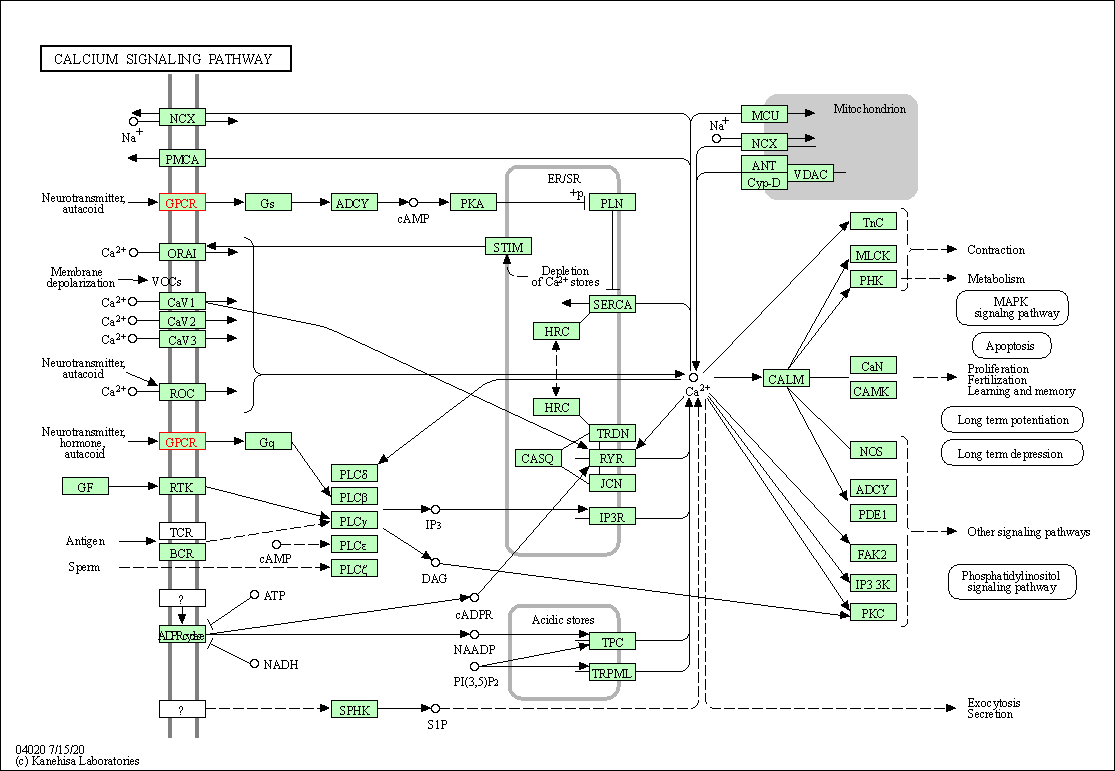
|
| Class: Environmental Information Processing => Signal transduction | Pathway Hierarchy | ||
| Neuroactive ligand-receptor interaction | hsa04080 | Affiliated Target |
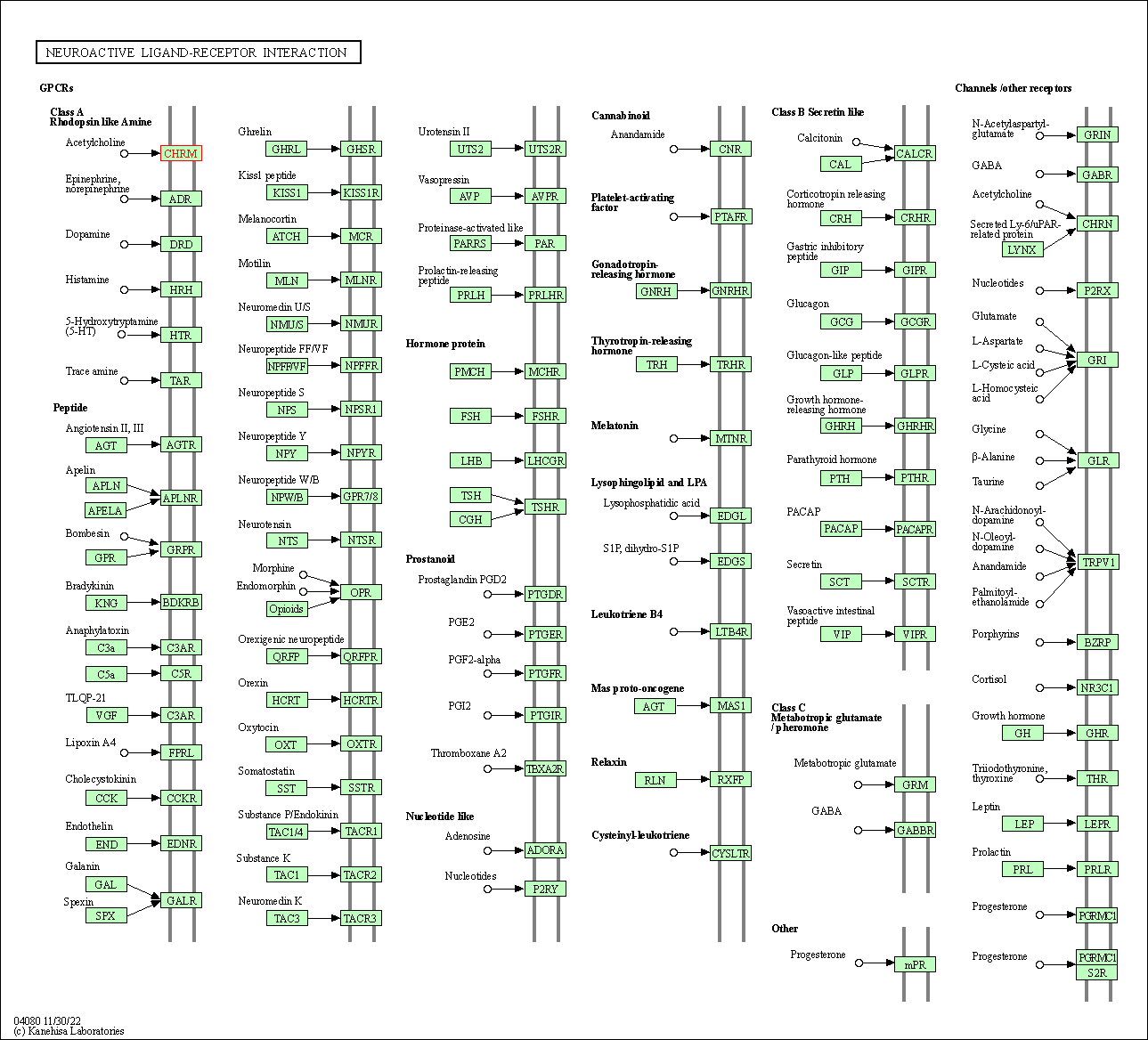
|
| Class: Environmental Information Processing => Signaling molecules and interaction | Pathway Hierarchy | ||
| Cholinergic synapse | hsa04725 | Affiliated Target |
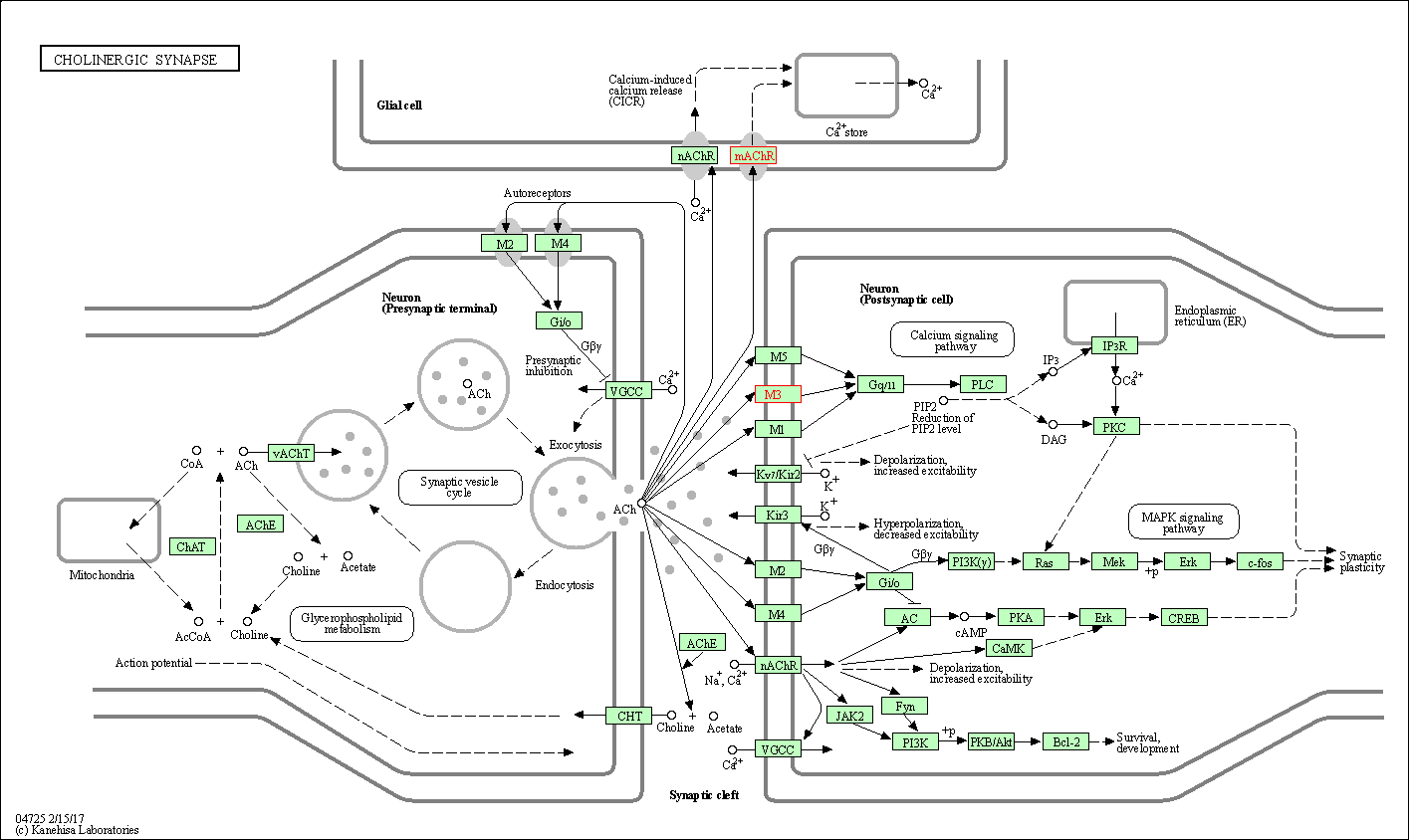
|
| Class: Organismal Systems => Nervous system | Pathway Hierarchy | ||
| Taste transduction | hsa04742 | Affiliated Target |
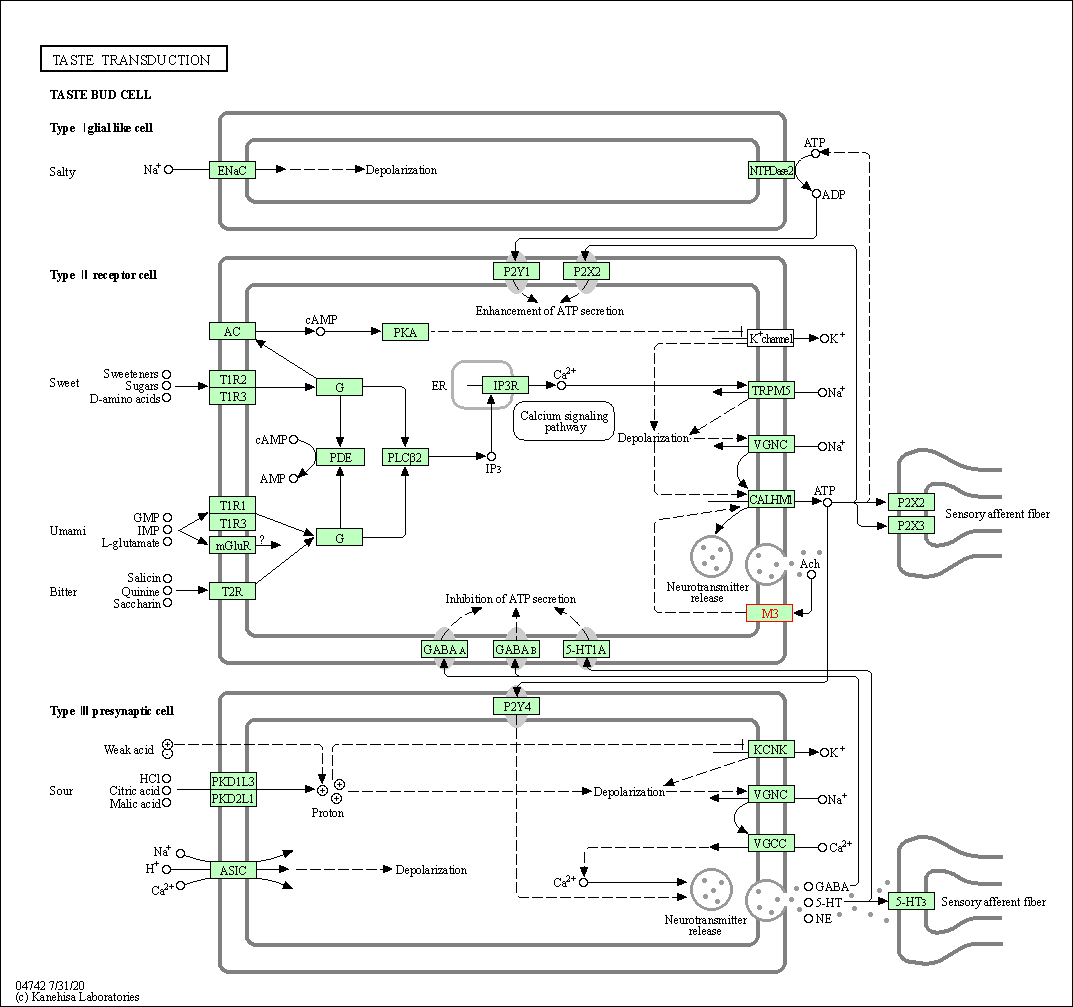
|
| Class: Organismal Systems => Sensory system | Pathway Hierarchy | ||
| Regulation of actin cytoskeleton | hsa04810 | Affiliated Target |
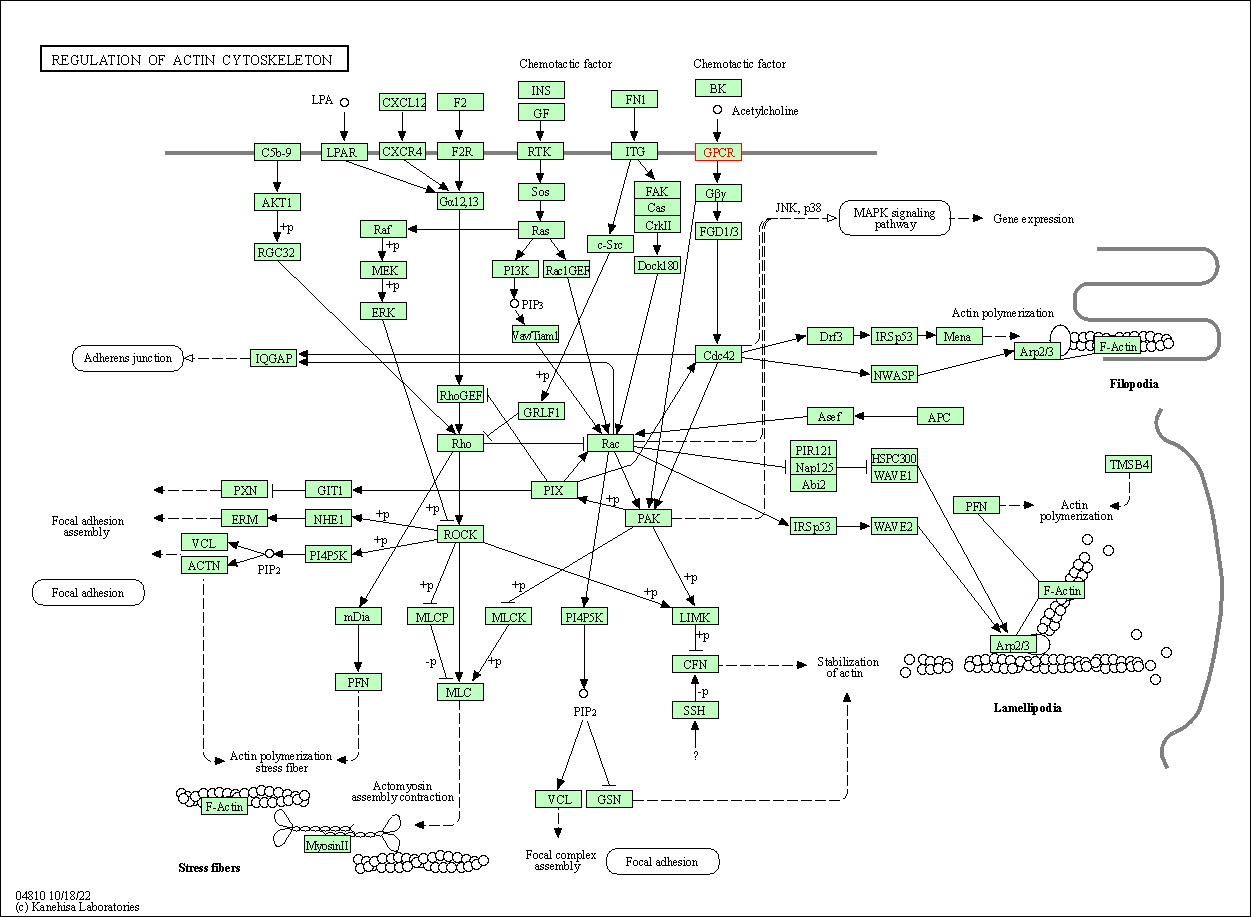
|
| Class: Cellular Processes => Cell motility | Pathway Hierarchy | ||
| Insulin secretion | hsa04911 | Affiliated Target |
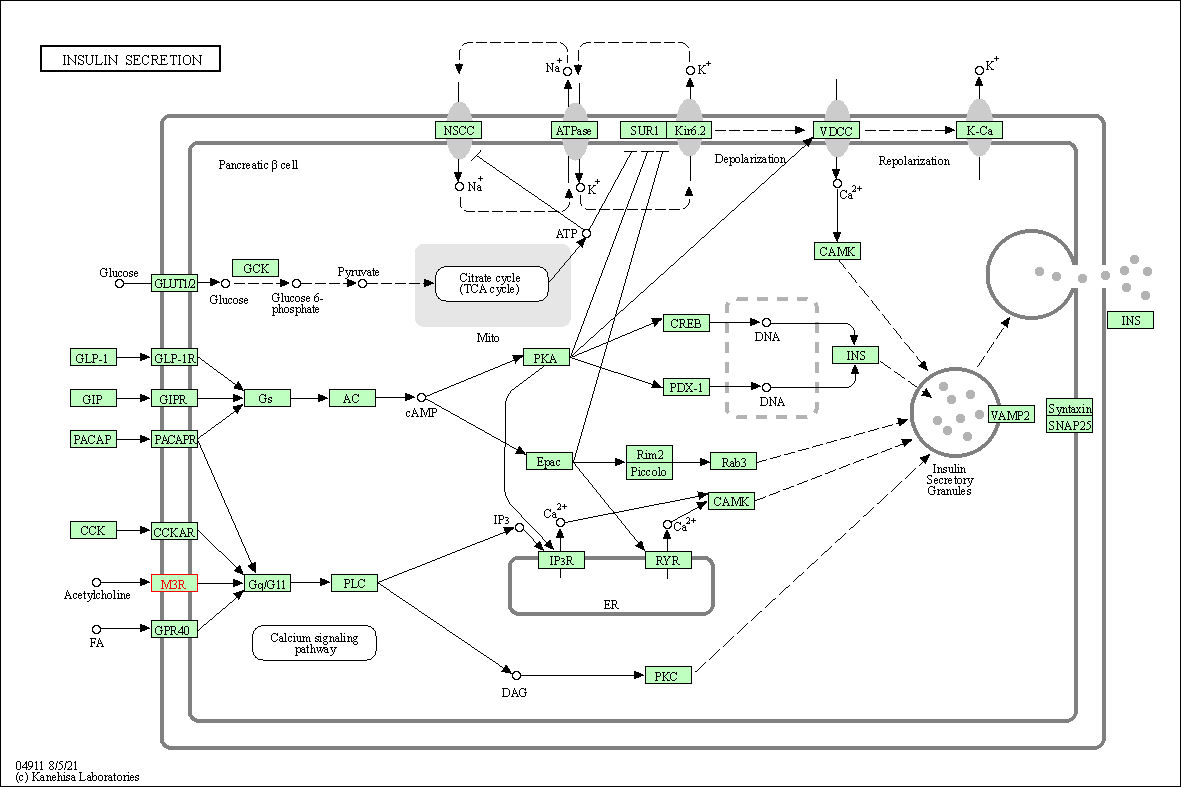
|
| Class: Organismal Systems => Endocrine system | Pathway Hierarchy | ||
| Salivary secretion | hsa04970 | Affiliated Target |
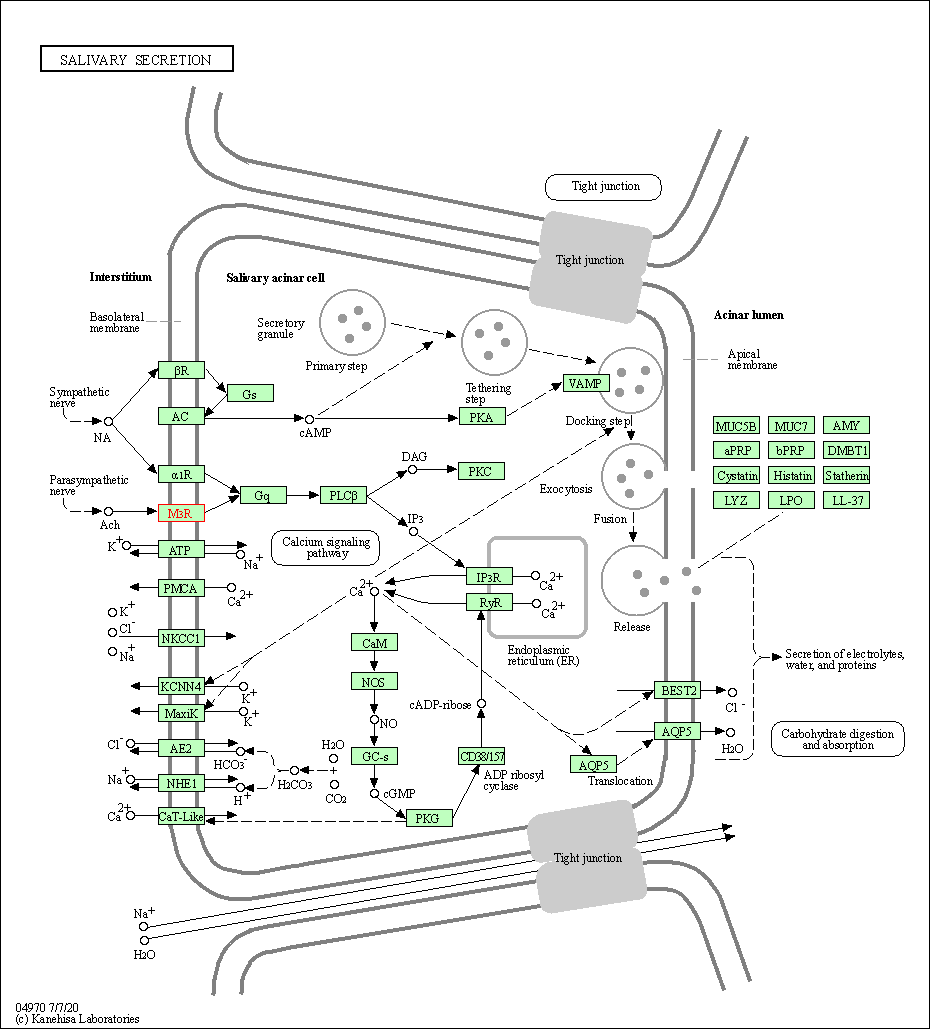
|
| Class: Organismal Systems => Digestive system | Pathway Hierarchy | ||
| Gastric acid secretion | hsa04971 | Affiliated Target |
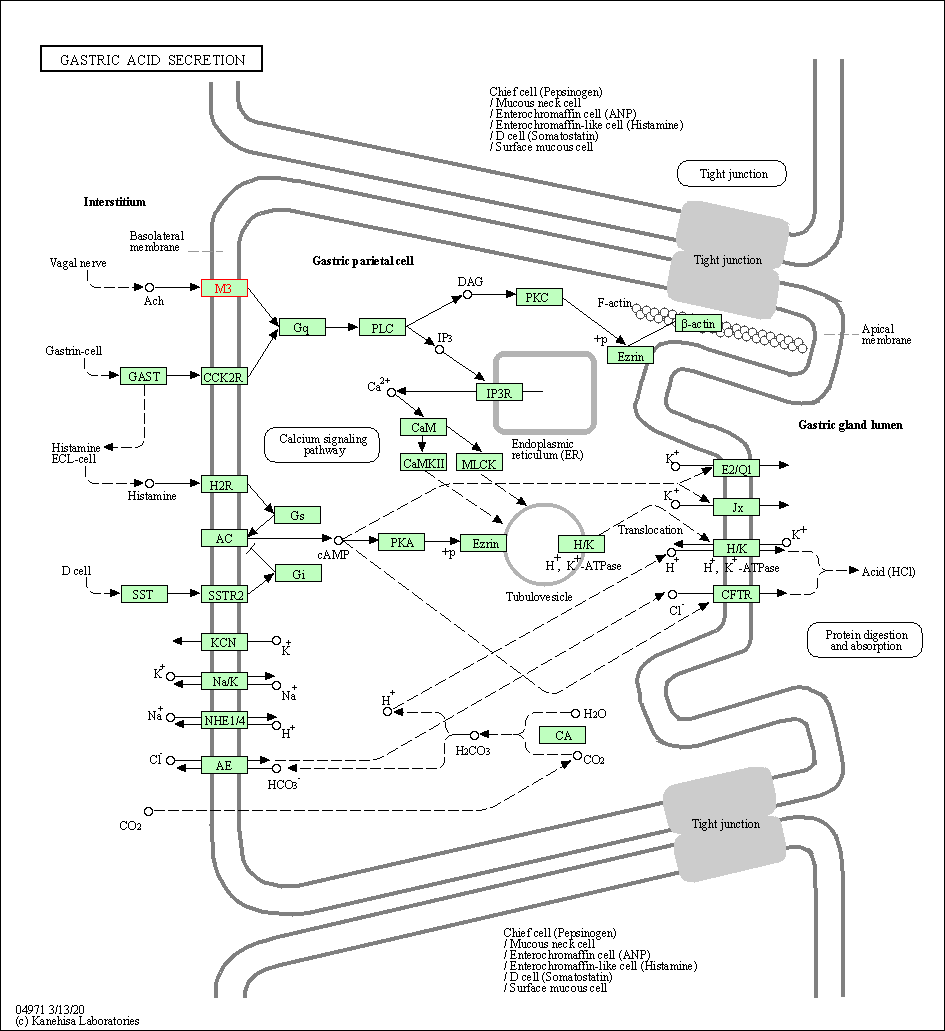
|
| Class: Organismal Systems => Digestive system | Pathway Hierarchy | ||
| Pancreatic secretion | hsa04972 | Affiliated Target |

|
| Class: Organismal Systems => Digestive system | Pathway Hierarchy | ||
| Click to Show/Hide the Information of Affiliated Human Pathways | |||
| Chemical Structure based Activity Landscape of Target | Top |
|---|---|
| Drug Property Profile of Target | Top | |
|---|---|---|
| (1) Molecular Weight (mw) based Drug Clustering | (2) Octanol/Water Partition Coefficient (xlogp) based Drug Clustering | |
|
|
||
| (3) Hydrogen Bond Donor Count (hbonddonor) based Drug Clustering | (4) Hydrogen Bond Acceptor Count (hbondacc) based Drug Clustering | |
|
|
||
| (5) Rotatable Bond Count (rotbonds) based Drug Clustering | (6) Topological Polar Surface Area (polararea) based Drug Clustering | |
|
|
||
| "RO5" indicates the cutoff set by lipinski's rule of five; "D123AB" colored in GREEN denotes the no violation of any cutoff in lipinski's rule of five; "D123AB" colored in PURPLE refers to the violation of only one cutoff in lipinski's rule of five; "D123AB" colored in BLACK represents the violation of more than one cutoffs in lipinski's rule of five | ||
| Co-Targets | Top | |||||
|---|---|---|---|---|---|---|
| Co-Targets | ||||||
| Target Poor or Non Binders | Top | |||||
|---|---|---|---|---|---|---|
| Target Poor or Non Binders | ||||||
| Target Profiles in Patients | Top | |||||
|---|---|---|---|---|---|---|
| Target Expression Profile (TEP) | ||||||
| Target-Related Models and Studies | Top | |||||
|---|---|---|---|---|---|---|
| Target Validation | ||||||
| Target QSAR Model | ||||||
| References | Top | |||||
|---|---|---|---|---|---|---|
| REF 1 | DrugBank: a knowledgebase for drugs, drug actions and drug targets. Nucleic Acids Res. 2008 Jan;36(Database issue):D901-6. | |||||
| REF 2 | URL: http://www.guidetopharmacology.org Nucleic Acids Res. 2015 Oct 12. pii: gkv1037. The IUPHAR/BPS Guide to PHARMACOLOGY in 2016: towards curated quantitative interactions between 1300 protein targets and 6000 ligands. (Ligand id: 321). | |||||
| REF 3 | Natural products as sources of new drugs over the last 25 years. J Nat Prod. 2007 Mar;70(3):461-77. | |||||
| REF 4 | 2004 approvals: the demise of the blockbuster. Nat Rev Drug Discov. 2005 Feb;4(2):93-4. | |||||
| REF 5 | URL: http://www.guidetopharmacology.org Nucleic Acids Res. 2015 Oct 12. pii: gkv1037. The IUPHAR/BPS Guide to PHARMACOLOGY in 2016: towards curated quantitative interactions between 1300 protein targets and 6000 ligands. (Ligand id: 288). | |||||
| REF 6 | Drugs@FDA. U.S. Food and Drug Administration. U.S. Department of Health & Human Services. 2015 | |||||
| REF 7 | Therapeutic effect of cevimeline on dry eye in patients with Sj gren's syndrome: a randomized, double-blind clinical study. Am J Ophthalmol. 2004 Jul;138(1):6-17. | |||||
| REF 8 | URL: http://www.guidetopharmacology.org Nucleic Acids Res. 2015 Oct 12. pii: gkv1037. The IUPHAR/BPS Guide to PHARMACOLOGY in 2016: towards curated quantitative interactions between 1300 protein targets and 6000 ligands. (Ligand id: 325). | |||||
| REF 9 | Emerging drugs for postoperative ileus. Expert Opin Emerg Drugs. 2007 Nov;12(4):619-26. | |||||
| REF 10 | Nat Rev Drug Discov. 2013 Feb;12(2):87-90. | |||||
| REF 11 | Aclidinium bromide, a novel long-acting muscarinic M3 antagonist for the treatment of COPD. Curr Opin Investig Drugs. 2009 May;10(5):482-90. | |||||
| REF 12 | URL: http://www.guidetopharmacology.org Nucleic Acids Res. 2015 Oct 12. pii: gkv1037. The IUPHAR/BPS Guide to PHARMACOLOGY in 2016: towards curated quantitative interactions between 1300 protein targets and 6000 ligands. (Ligand id: 316). | |||||
| REF 13 | Drug information of Methylscopolamine, 2008. eduDrugs. | |||||
| REF 14 | Clinical pipeline report, company report or official report of Summit. | |||||
| REF 15 | URL: http://www.guidetopharmacology.org Nucleic Acids Res. 2015 Oct 12. pii: gkv1037. The IUPHAR/BPS Guide to PHARMACOLOGY in 2016: towards curated quantitative interactions between 1300 protein targets and 6000 ligands. (Ligand id: 7483). | |||||
| REF 16 | FDA Approved Drug Products from FDA Official Website. 2009. Application Number: (NDA) 021518. | |||||
| REF 17 | URL: http://www.guidetopharmacology.org Nucleic Acids Res. 2015 Oct 12. pii: gkv1037. The IUPHAR/BPS Guide to PHARMACOLOGY in 2016: towards curated quantitative interactions between 1300 protein targets and 6000 ligands. (Ligand id: 4004). | |||||
| REF 18 | FDA Approved Drug Products from FDA Official Website. 2009. Application Number: (NDA) 008453. | |||||
| REF 19 | URL: http://www.guidetopharmacology.org Nucleic Acids Res. 2015 Oct 12. pii: gkv1037. The IUPHAR/BPS Guide to PHARMACOLOGY in 2016: towards curated quantitative interactions between 1300 protein targets and 6000 ligands. (Ligand id: 367). | |||||
| REF 20 | ClinicalTrials.gov (NCT01458197) A Phase 2 Study to Compare the Efficacy and Tolerability of Tarafenacin 0.2 mg and Tarafenacin 0.4 mg to Placebo in Patients Suffering From Overactive Bladder.. U.S. National Institutes of Health. | |||||
| REF 21 | ClinicalTrials.gov (NCT02382510) Multiple Ascending Dose Study of TRN-157 in Stable Mild and Moderate Asthmatics. U.S. National Institutes of Health. | |||||
| REF 22 | Emerging drugs in chronic obstructive pulmonary disease. Expert Opin Emerg Drugs. 2009 Mar;14(1):181-94. | |||||
| REF 23 | Trusted, scientifically sound profiles of drug programs, clinical trials, safety reports, and company deals, written by scientists. Springer. 2015. Adis Insight (drug id 800003650) | |||||
| REF 24 | Trusted, scientifically sound profiles of drug programs, clinical trials, safety reports, and company deals, written by scientists. Springer. 2015. Adis Insight (drug id 800022973) | |||||
| REF 25 | Emerging drugs for the treatment of chronic obstructive pulmonary disease. Expert Opin Emerg Drugs. 2006 May;11(2):275-91. | |||||
| REF 26 | In vivo muscarinic cholinergic mediated effects of Lu 25-109, a M1 agonist and M2/M3 antagonist in vitro. Psychopharmacology (Berl). 1998 Jun;137(3):233-40. | |||||
| REF 27 | Design, synthesis, and neurochemical evaluation of 5-(3-alkyl-1,2,4- oxadiazol-5-yl)-1,4,5,6-tetrahydropyrimidines as M1 muscarinic receptor agonists. J Med Chem. 1993 Apr 2;36(7):842-7. | |||||
| REF 28 | Degradation of submandibular gland AQP5 by parasympathetic denervation of chorda tympani and its recovery by cevimeline, an M3 muscarinic receptor ... Am J Physiol Gastrointest Liver Physiol. 2008 Jul;295(1):G112-G123. | |||||
| REF 29 | Role of parasympathetic nerves and muscarinic receptors in allergy and asthma.Chem Immunol Allergy.2012;98:48-69. | |||||
| REF 30 | Muscarinic M3-receptors mediate cholinergic synergism of mitogenesis in airway smooth muscle. Am J Respir Cell Mol Biol. 2003 Feb;28(2):257-62. | |||||
| REF 31 | Agonist-regulated alteration of the affinity of pancreatic muscarinic cholinergic receptors. J Biol Chem. 1993 Oct 25;268(30):22436-43. | |||||
| REF 32 | Interaction of neuromuscular blocking drugs with recombinant human m1-m5 muscarinic receptors expressed in Chinese hamster ovary cells. Br J Pharmacol. 1998 Nov;125(5):1088-94. | |||||
| REF 33 | Demonstration of bladder selective muscarinic receptor binding by intravesical oxybutynin to treat overactive bladder. J Urol. 2004 Nov;172(5 Pt 1):2059-64. | |||||
| REF 34 | Comparison of muscarinic receptor selectivity of solifenacin and oxybutynin in the bladder and submandibular gland of muscarinic receptor knockout ... Eur J Pharmacol. 2009 Aug 1;615(1-3):201-6. | |||||
| REF 35 | The involvement of histaminic and muscarinic receptors in the bronchoconstriction induced by myorelaxant administration in sensitized rabbits. Anesth Analg. 2008 Dec;107(6):1899-906. | |||||
| REF 36 | Neuromuscular relaxants as antagonists for M2 and M3 muscarinic receptors. Anesthesiology. 1998 Mar;88(3):744-50. | |||||
| REF 37 | Pharmacological characterization of GSK573719 (umeclidinium): a novel, long-acting, inhaled antagonist of the muscarinic cholinergic receptors for treatment of pulmonary diseases. J Pharmacol Exp Ther. 2013 May;345(2):260-70. | |||||
| REF 38 | Signal transduction underlying carbachol-induced contraction of human urinary bladder. J Pharmacol Exp Ther. 2004 Jun;309(3):1148-53. | |||||
| REF 39 | Knockouts model the 100 best-selling drugs--will they model the next 100 Nat Rev Drug Discov. 2003 Jan;2(1):38-51. | |||||
| REF 40 | In vivo and in vitro pharmacological characterization of SVT-40776, a novel M3 muscarinic receptor antagonist, for the treatment of overactive bladder. Br J Pharmacol. 2009 Mar;156(5):807-17. | |||||
| REF 41 | URL: http://www.guidetopharmacology.org Nucleic Acids Res. 2015 Oct 12. pii: gkv1037. The IUPHAR/BPS Guide to PHARMACOLOGY in 2016: towards curated quantitative interactions between 1300 protein targets and 6000 ligands. (Target id: 15). | |||||
| REF 42 | Drug treatment options for irritable bowel syndrome: managing for success. Drugs Aging. 2001;18(3):201-11. | |||||
| REF 43 | Interpreting expression profiles of cancers by genome-wide survey of breadth of expression in normal tissues. Genomics 2005 Aug;86(2):127-41. | |||||
| REF 44 | Discovery & development of selective M3 antagonists for clinical use.Life Sci.1997;60(13-14):1053-60. | |||||
| REF 45 | Synthesis and biological evaluation of [125I]- and [123I]-4-iododexetimide, a potent muscarinic cholinergic receptor antagonist. J Med Chem. 1989 May;32(5):1057-62. | |||||
| REF 46 | Discovery of (3-endo)-3-(2-cyano-2,2-diphenylethyl)-8,8-dimethyl-8-azoniabicyclo[3.2.1]octane bromide as an efficacious inhaled muscarinic acetylch... Bioorg Med Chem Lett. 2009 Aug 15;19(16):4560-2. | |||||
| REF 47 | Urea and 2-imidazolidone derivatives of the muscarinic agents oxotremorine and N-methyl-N-(1-methyl-4-pyrrolidino-2-butynyl)acetamide. J Med Chem. 1992 Aug 21;35(17):3270-9. | |||||
| REF 48 | Synthesis and modeling studies of a potent conformationally rigid muscarinic agonist: 1-azabicyclo[2.2.1]heptanespirofuranone. J Med Chem. 1998 Oct 22;41(22):4181-5. | |||||
| REF 49 | Designing active template molecules by combining computational de novo design and human chemist's expertise. J Med Chem. 2007 Apr 19;50(8):1925-32. | |||||
| REF 50 | Cholinergic agents: aldehyde, ketone, and oxime analogues of the muscarinic agonist UH5, Bioorg. Med. Chem. Lett. 2(8):803-808 (1992). | |||||
| REF 51 | Synthesis and muscarinic activities of quinuclidin-3-yltriazole and -tetrazole derivatives. J Med Chem. 1992 Apr 3;35(7):1280-90. | |||||
| REF 52 | Discovery of N-{1-[3-(3-oxo-2,3-dihydrobenzo[1,4]oxazin-4-yl)propyl]piperidin-4-yl}-2-phenylacetamide (Lu AE51090): an allosteric muscarinic M1 rec... J Med Chem. 2010 Sep 9;53(17):6386-97. | |||||
| REF 53 | An increase in intracelluar free calcium ions modulated by cholinergic receptors in rat facial nucleus. Chin Med J (Engl). 2009 May 5;122(9):1049-55. | |||||
| REF 54 | The effects of the antagonists of muscarinic acetylcholine receptor subtypes in rat brain on urinary bladder contraction. Nippon Hinyokika Gakkai Zasshi. 2002 Mar;93(3):427-34. | |||||
| REF 55 | cis-4-(Piperazin-1-yl)-5,6,7a,8,9,10,11,11a-octahydrobenzofuro[2,3-h]quinazolin-2-amine (A-987306), a new histamine H4R antagonist that blocks pain... J Med Chem. 2008 Nov 27;51(22):7094-8. | |||||
| REF 56 | 6beta-Acetoxynortropane: a potent muscarinic agonist with apparent selectivity toward M2-receptors. J Med Chem. 1998 Jun 4;41(12):2047-55. | |||||
| REF 57 | Positive cooperativity of acetylcholine and other agonists with allosteric ligands on muscarinic acetylcholine receptors. Mol Pharmacol. 1997 Jul;52(1):172-9. | |||||
| REF 58 | 6beta-Acyloxy(nor)tropanes: affinities for antagonist/agonist binding sites on transfected and native muscarinic receptors. J Med Chem. 2000 Jun 29;43(13):2514-22. | |||||
| REF 59 | A novel and selective class of azabicyclic muscarinic agonists incorporating an N-methoxy imidoyl halide or nitrile functionality, Bioorg. Med. Chem. Lett. 2(8):791-796 (1992). | |||||
| REF 60 | Subtype-selective positive cooperative interactions between brucine analogues and acetylcholine at muscarinic receptors: radioligand binding studies. Mol Pharmacol. 1998 Mar;53(3):573-89. | |||||
| REF 61 | Synthesis, absolute configuration, conformational analysis and binding affinity properties of enantiomeric forms of DAU 5750, a novel M1-M3 muscari... Bioorg Med Chem. 1994 Dec;2(12):1375-83. | |||||
| REF 62 | Doi: 10.1038/bjp.2008.208 | |||||
| REF 63 | Synthesis and pharmacological evaluation of a series of 4-piperazinylpyrazolo[3,4-b]- and -[4,3-b][1,5]benzodiazepines as potential anxiolytics. J Med Chem. 1989 Dec;32(12):2573-82. | |||||
| REF 64 | Design and synthesis of a fluorescent muscarinic antagonist. Bioorg Med Chem Lett. 2008 Jan 15;18(2):825-7. | |||||
| REF 65 | Nocardimicins A, B, C, D, E, and F, siderophores with muscarinic M3 receptor inhibiting activity from Nocardia sp. TP-A0674. J Nat Prod. 2005 Jul;68(7):1061-5. | |||||
| REF 66 | Allosteric interactions of staurosporine and other indolocarbazoles with N-[methyl-(3)H]scopolamine and acetylcholine at muscarinic receptor subtypes: identification of a second allosteric site. Mol Pharmacol. 2000 Jul;58(1):194-207. | |||||
| REF 67 | Binding of the labelled muscarinic toxin 125I-MT1 to rat brain muscarinic M1 receptors. Eur J Pharmacol. 1996 Jun 3;305(1-3):187-92. | |||||
| REF 68 | Antagonist binding properties of five cloned muscarinic receptors expressed in CHO-K1 cells. Mol Pharmacol. 1989 Apr;35(4):469-76. | |||||
| REF 69 | Chloro-substituted, sterically hindered 5,11-dicarbo analogues of clozapine as potential chiral antipsychotic agents. J Med Chem. 1990 Feb;33(2):809-14. | |||||
| REF 70 | Synthesis of clozapine analogues and their affinity for clozapine and spiroperidol binding sites in rat brain. J Med Chem. 1981 Sep;24(9):1021-6. | |||||
| REF 71 | Lithocholylcholine, a bile acid/acetylcholine hybrid, is a muscarinic receptor antagonist. J Pharmacol Exp Ther. 2002 Oct;303(1):29-35. | |||||
| REF 72 | Human muscarinic receptors expressed in A9L and CHO cells: activation by full and partial agonists. Br J Pharmacol. 1995 Mar;114(6):1241-9. | |||||
| REF 73 | Discovery, synthesis and characterization of a highly muscarinic acetylcholine receptor (mAChR)-selective M5-orthosteric antagonist, VU0488130 (ML381): a novel molecular probe. ChemMedChem. 2014 Aug;9(8):1677-82. | |||||
| REF 74 | Synthesis and pharmacological evaluation of dimeric muscarinic acetylcholine receptor agonists. J Pharmacol Exp Ther. 2001 Sep;298(3):1260-8. | |||||
| REF 75 | Which muscarinic receptor is important in the bladder World J Urol. 2001 Nov;19(5):299-306. | |||||
| REF 76 | Generation of an agonistic binding site for blockers of the M(3) muscarinic acetylcholine receptor. Biochem J. 2008 May 15;412(1):103-12. | |||||
| REF 77 | Stimulation of cyclic AMP accumulation and phosphoinositide hydrolysis by M3 muscarinic receptors in the rat peripheral lung. Biochem Pharmacol. 1996 Aug 23;52(4):643-58. | |||||
| REF 78 | Heterocyclic muscarinic agonists. Synthesis and biological activity of some bicyclic sulfonium arecoline bioisosteres. J Med Chem. 1988 Jul;31(7):1312-6. | |||||
| REF 79 | Thiochrome enhances acetylcholine affinity at muscarinic M4 receptors: receptor subtype selectivity via cooperativity rather than affinity. Mol Pharmacol. 2004 Jan;65(1):257-66. | |||||
| REF 80 | Design, synthesis, and biological evaluation of pirenzepine analogs bearing a 1,2-cyclohexanediamine and perhydroquinoxaline units in exchange for the piperazine ring as antimuscarinics. Bioorg Med Chem. 2008 Aug 1;16(15):7311-20. | |||||
| REF 81 | Dual M3 antagonists-PDE4 inhibitors. Part 2: Synthesis and SAR of 3-substituted azetidinyl derivatives. Bioorg Med Chem Lett. 2007 Jun 1;17(11):3077-80. | |||||
| REF 82 | Comparison of the in vitro and in vivo profiles of tolterodine with those of subtype-selective muscarinic receptor antagonists. Eur J Pharmacol. 1998 May 22;349(2-3):285-92. | |||||
| REF 83 | A novel selective muscarinic acetylcholine receptor subtype 1 antagonist reduces seizures without impairing hippocampus-dependent learning. Mol Pharmacol. 2009 Aug;76(2):356-68. | |||||
| REF 84 | Analogs of WIN 62,577 define a second allosteric site on muscarinic receptors. Mol Pharmacol. 2002 Dec;62(6):1492-505. | |||||
| REF 85 | Distinct primary structures, ligand-binding properties and tissue-specific expression of four human muscarinic acetylcholine receptors. EMBO J. 1987 Dec 20;6(13):3923-9. | |||||
If You Find Any Error in Data or Bug in Web Service, Please Kindly Report It to Dr. Zhou and Dr. Zhang.

